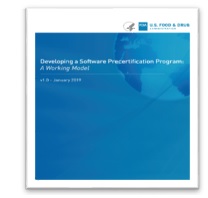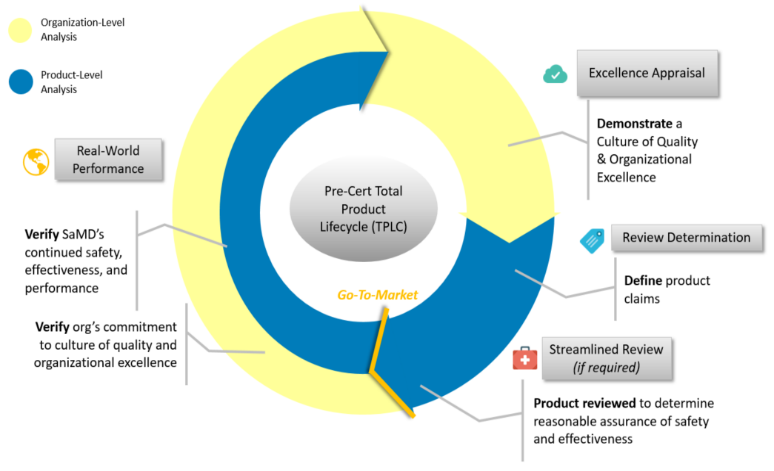Digital Health Software Precertification (Pre-Cert) Program
Advancing Development of the Pre-Cert Program
The FDA is partnering with a Federally Funded Research and Development Center (FFRDC), operated by The MITRE Corporation (MITRE), to provide professional engineering and technical support to simulate scenarios for the Software Pre-Cert Pilot Program, as introduced in the September 2020 Update. The simulated scenarios will allow the agency to test the interdependencies of the four components of the Pre-Cert Pilot Program (Excellence Appraisal, Review Pathway Determination, Streamlined Premarket Review Process and Real-World Performance) and to help uncover unknowns as we continue to build and test the program. The FDA will continue to provide public updates on the development of the program.
On this page:
- What is the Software Pre-Cert Pilot Program?
- How does the Pre-Cert Pilot Program work?
- What is the goal of the program?
- Who is currently involved in the program?
- How can I provide feedback on the Pre-Cert Program
What Is the Software Pre-Cert Pilot Program?
The Software Precertification (Pre-Cert) Pilot Program, as outlined in the FDA's Digital Health Innovation Action Plan [PDF], will help inform the development of a future regulatory model that will provide more streamlined and efficient regulatory oversight of software-based medical devices developed by manufacturers who have demonstrated a robust culture of quality and organizational excellence, and who are committed to monitoring real-world performance of their products once they reach the U.S. market.
This proposed approach aims to look first at the software developer or digital health technology developer, rather than primarily at the product, which is what we currently do for traditional medical devices. Because software products can be adapted to respond to glitches, adverse events, and other safety concerns quickly, the FDA is working to establish a regulatory framework that is equally responsive when issues arise to help ensure consumers continue to have access to safe and effective products. In the Pre-Cert program, the FDA is proposing that software products from precertified companies would continue to meet the same safety and effectiveness standard that the agency expects for products that have followed the traditional path to market.
This pilot is an important first step to help us explore and evaluate the program model to inform how we establish the Pre-Cert Program. Pre-Cert 1.0, the first version of the program that was available for pilot testing within the FDA's current authorities in 2019, is limited to manufacturers of software as a medical device (SaMD). Learn more about software as a medical device (SaMD).
As the FDA leverages insights from testing of Pre-Cert 1.0, we may find that the voluntary program could include software in a medical device (SiMD) or other software that could be considered accessories to hardware medical devices.
How Does the Pre-Cert Pilot Program Work?
The Software Precertification Pilot Program version 1.0 Working Model (PDF) explains how the FDA has reimagined its way of regulating digital health products and details the proposed key components of the Pre-Cert pilot program.
In 2019, the Software Pre-Cert program entered its test phase and the FDA shared the Test Plan (PDF).
The FDA's Test Plan is designed to assess whether the Excellence Appraisal and Streamlined Review components together produce an equivalent basis for determining reasonable assurance of safety and effectiveness for a software device prior to its introduction to the market, as compared to the FDA's traditional models.
The FDA describes how it plans to implement the Pre-Cert Pilot Program within its current authorities in the Regulatory Framework. Learn more about the Regulatory Framework for the Pre-Cert model.
In addition, the 2020 Update summarizes the FDA's test activities, provides an update on our progress, shares what we have learned, and outlines next steps. For more information, see Developing the Software Precertification Program: Summary of Learnings and Ongoing Activities: 2020 Update [PDF - 1.5 MB].
Proposed Key Components of a Future Pre-Cert Program:
Total Product Lifecycle Approach of the Software Precertification Program
The FDA's Total Product Lifecycle (TPLC) approach enables the evaluation and monitoring of a software product from its premarket development to postmarket performance, along with continued demonstration of the organization's excellence. Learn more about this approach in the version 1.0 working model (PDF).
- Excellence Appraisal: Identifying the objective criteria and methodology that the FDA will use to pre-certify a company and decide whether a company can keep its precertification status.
The FDA is currently basing the Pilot Program's criteria on five excellence principles: patient safety, product quality, clinical responsibility, cybersecurity responsibility, and proactive culture. The FDA is currently considering two levels of precertification based on how a company meets the excellence principles and whether it has demonstrated a track record in delivering safe and effective software products. - Review Determination: Developing a risk-based framework so a precertified company can determine the premarket review pathway for their products. Potentially precertified companies could market their lower-risk devices without the FDA's premarket review or only a streamlined premarket review based on the company's precertification level and International Medical Device Regulators Forum (IMDRF) risk categorization.
The FDA is planning to leverage the IMDRF framework, to the extent consistent with current statutory authority, to help determine the risk categorization of a SaMD product, incorporating information about the medical purpose of the SaMD and the seriousness of the medical condition that the SaMD is intended to treat.
The FDA is also considering appropriate means to educate patients and providers about the premarket review and postmarket monitoring obligations for each SaMD risk category. - Streamlined Review: Identifying the type of information that a precertified company would include in its premarket submission for the FDA to review software products for safety and effectiveness before patients access them.
The FDA is exploring using an interactive streamlined review of a SaMD with information the agency already has gained from the process to precertify a company, and additional information the company would share about the SaMD's product performance, clinical association between the SaMD output and a clinical condition, and safety measures. - Real-world Performance: Identifying the type of information that may be available to or accessibly by a precertified company about how its software product is performing with patients to support the regulatory status of the product and new and evolving product functions.
The FDA is considering how best to work with a company to collect and interpret real-world information about a SaMD and to evolve the product's safety and effectiveness to address any emerging risks. The sources of real world performance data may include information about a user's experience, software performance data, and clinical outcomes.
What is the Goal of the Pre-Cert Pilot Program?
The goal of the program is to have tailored, pragmatic, and least burdensome regulatory oversight that assesses organizations (large and small) to establish trust that they have a culture of quality and organizational excellence such that they can develop high quality SaMD products, leverages transparency of organizational excellence and product performance across the entire lifecycle of SaMD, utilizes a tailored streamlined premarket review, and leverages unique postmarket opportunities available in software to verify the continued safety, effectiveness, and performance of SaMD in the real-world.
The Software Precertification (Pre-Cert) Program's aims are to:
- Benefit a participating organization based on its "precertified" status by offering the ability to participate in a streamlined premarket review and opportunities to collect and leverage real-world postmarket data, which encourages innovation, timely patient access, and safety and effectiveness over the product life cycle.
- Leverage and use information and data from all available sources allowing FDA and SaMD manufacturers to be more efficient and streamlined without compromising safety and effectiveness of SaMD products.
- Enable a modern and tailored approach that allows software iterations and changes to occur in a timely fashion under appropriate controls.
- Ensure high-quality software products throughout the life of the product by enabling companies to demonstrate their embedded culture of quality and organizational excellence and ability to monitor real-world performance.
- Adapt key elements and measure based on the effectiveness of the program.
Who Is Currently Involved in the Pre-Cert Pilot Program?
In September 2017, the FDA selected nine companies out of over 100 applicants to participate in the development of the Software Pre-Cert pilot program:
- Apple
- Fitbit
- Johnson & Johnson
- Pear Therapeutics
- Phosphorus
- Roche
- Samsung
- Tidepool
- Verily
The details of selection criteria for the pilot program were published in the Software Precertification Pilot Program Federal Register notice.
How Can I Provide Feedback on the Pre-Cert Program?
The FDA continues to seek input on the Pre-Cert version 1.0 working model (PDF) through the public docket. The FDA encourages stakeholders to self-organize as groups and provide consolidated feedback on the Pre-Cert working model. Your input will help shape the next steps that we take to build the Pre-Cert program.
Submit Formal Comments on this Pilot Program
Email Specific Questions about the Pilot Program
For more information:
- Follow us on Twitter; #FDAPrecert
- Review Frequently Asked Questions about the Pre-Cert Program
- Digital Health Software Precertification (Pre-Cert) Pilot Program User Session - February 7, 2019
- Review materials from the January 2018 public workshop
- Digital Health Innovation Action Plan (PDF - 783KB)
- Webinar - Digital Health Software Precertification (Pre-Cert) Pilot Program - August 1, 2017
- FDA Voices: New Steps to Empower Consumers and Advance Digital Healthcare (July 27, 2017)
- Developing the Software Precertification Program: Summary of Learnings and Ongoing Activities: 2020 Update (PDF - 1.5 MB)


